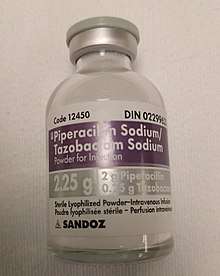Piperacillin/tazobactam
Piperacillin/tazobactam, sold under the brand names Zosyn among others, is a combination medication containing the antibiotic piperacillin and the β-lactamase inhibitor tazobactam.[2] The combination has activity against many Gram-positive and Gram-negative bacteria including Pseudomonas aeruginosa.[2] It is used to treat pelvic inflammatory disease, intra-abdominal infection, pneumonia, cellulitis, and sepsis.[2] It is given by injection into a vein.[3]
 Bottle of piperacillin/tazobactam | |
| Combination of | |
|---|---|
| Piperacillin | Ureidopenicillin antibiotic |
| Tazobactam | Beta-lactamase inhibitor |
| Clinical data | |
| Trade names | Tazocin, Zosyn, others[1] |
| AHFS/Drugs.com | Monograph |
| MedlinePlus | a694003 |
| Pregnancy category |
|
| Routes of administration | Intravenous infusion |
| ATC code | |
| Legal status | |
| Legal status | |
| Identifiers | |
| CAS Number | |
| PubChem CID | |
| ChemSpider | |
| ChEMBL | |
| CompTox Dashboard (EPA) | |
| | |
Common adverse effects include headache, trouble sleeping, rash, nausea, constipation, and diarrhea.[2] Serious adverse effects include Clostridium difficile infection and allergic reactions including anaphylaxis.[2] Those who are allergic to other β-lactam are more likely to be allergic to piperacillin/tazobactam.[2] Use in pregnancy or breastfeeding appears to generally be safe.[4] It usually results in bacterial death through blocking their ability to make a cell wall.[2]
Piperacillin/tazobactam was approved for medical use in the United States in 1993.[2] It is on the World Health Organization's List of Essential Medicines.[5] It is available as a generic medication.[3]
Medical uses
Its main uses are in intensive care medicine (pneumonia, peritonitis), some diabetes-related foot infections, and empirical therapy in febrile neutropenia (e.g., after chemotherapy). The drug is administered intravenously every 6 or 8 hr, typically over 3–30 min. It may also be administered by continuous infusion over four hours. Prolonged infusions are thought to maximize the time that serum concentrations are above the minimum inhibitory concentration (MIC) of the bacteria implicated in infection.
Piperacillin-tazobactam is recommended by the National Institute for Health and Care Excellence as first line therapy for the treatment of bloodstream infections in neutropenic cancer patients.[6]
For β-lactam antipseudomonal antibiotics, including piperacillin/tazobactam, prolonged intravenous infusion is associated with lower mortality than bolus intravenous infusion in persons with sepsis due to Pseudomonas aeruginosa.[7]
Adverse effects
The most common adverse effect is diarrhea (7–11%).[8] Another adverse effect is inhibition of platelets (thrombocytopenia).[9]
Society and culture
Trade names
Apart from Tazocin and Zosyn, the drug is marketed in various countries under other trade names such as Tazact, Biopiper TZ, Brodactam, Piptaz, Maxitaz, Kilbac, Trezora, Du-Tazop, Tazopen, Sytaz, Tazin, and Inzalin TZ.
2017 shortage
Various sources have referred to a shortage of the drug since May 2017, citing various reasons, including an earthquake in China and other issues at the major production facility in 海正 (Hisun); increased demand; withdrawal of funding by a major pharmaceutical company.[10][11]
References
- "Tazocin". Drugs.com. Retrieved 22 January 2020.
- "Piperacillin Sodium and Tazobactam Sodium". The American Society of Health-System Pharmacists. Retrieved 8 December 2017.
- British national formulary : BNF 69 (69 ed.). British Medical Association. 2015. p. 373. ISBN 9780857111562.
- "Piperacillin / tazobactam (Zosyn) Use During Pregnancy". Drugs.com. Retrieved 10 December 2017.
- World Health Organization (2019). World Health Organization model list of essential medicines: 21st list 2019. Geneva: World Health Organization. hdl:10665/325771. WHO/MVP/EMP/IAU/2019.06. License: CC BY-NC-SA 3.0 IGO.
- Neutropenic Sepsis: Prevention and Management of Neutropenic Sepsis in Cancer Patients - National Library of Medicine - PubMed Health. National Institute for Health and Care Excellence: Guidance. National Institute for Health and Clinical Excellence (UK). 2012.
- Vardakas KZ, Voulgaris GL, Maliaros A, Samonis G, Falagas ME (January 2018). "Prolonged versus short-term intravenous infusion of antipseudomonal β-lactams for patients with sepsis: a systematic review and meta-analysis of randomised trials". Lancet Infect Dis. 18 (1): 108–120. doi:10.1016/S1473-3099(17)30615-1. PMID 29102324.
- "Piperacillin and Tazobactam Sodium". Merck Manual Professional. Archived from the original on November 20, 2010.
- Rousan TA, Aldoss IT, Cowley BD Jr, Curtis BR, Bougie DW, Aster RH, George JN (January 2010). "Recurrent acute thrombocytopenia in the hospitalized patient: Sepsis, DIC, HIT, or antibiotic-induced thrombocytopenia". American Journal of Hematology. 85 (1): 71–74. doi:10.1002/ajh.21536. PMC 4410979. PMID 19802882.
- "Drug Shortages › Piperacillin Tazobactam Injection". Drugs.com. 10 July 2017. Retrieved 12 July 2017.
- "Major shortage forces doctors to ration important antibiotic". RT.com. 1 July 2017. Retrieved 12 July 2017.